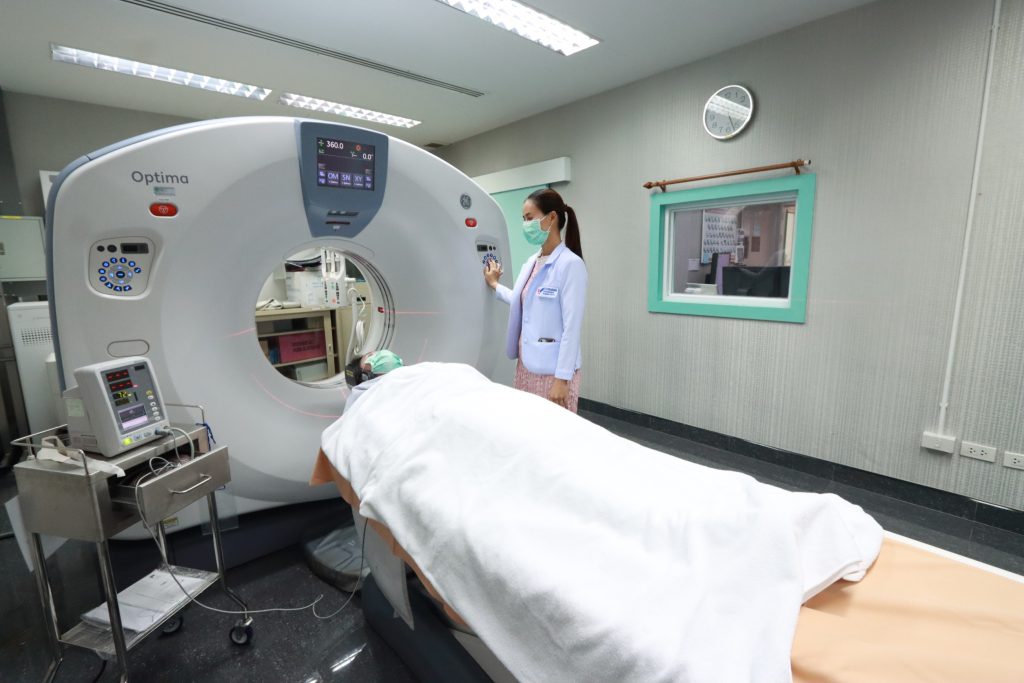- Home
- Medical Technology
- CT Scan 128 Slice

High-speed computed tomography can scan patients up to 128 slices per 1 rotation, taking less than 0.4 seconds. Thus, the physical examination with CT SCAN provides a sharper and more detailed photograph. This technology has a radiation reduction program of up to 82% for safety. Even pediatric patients can SCAN and the examination is faster until they can examine organs that are constantly moving like the heart. The resulting photograph is a 3D image that is sharper. A photograph can be viewed in different planes, including visualization similar to endoscopic examination to diagnose various diseases as follows:
- Brain tissue abnormalities (Brain CT)
- Abnormalities of abdominal organs (Abdominal CT)
- Abnormalities examined from Bones in different parts of the body
- Coronary Calcium Score
- Early tumors in the lung tissue
- Coronary CT Angiography (CTA)
CT Scan 128 Slice for Coronary Artery Examination
Since the heart is constantly moving, examination of the heart or coronary arteries is therefore more difficult than examining other organs. Computerized tomography with very high speed can examine coronary arteries by injecting contrast media into the veins in the arm. Then, the machine is set to scan the contrast media to examine the severity of the CAD as well as the amount of limestone or fat to plan the treatment that is suitable for the patient.
For the examination of the coronary arteries with CT Scan 128 Slice, does it take a long time? Does it hurt? or is it dangerous?
The examination of coronary arteries with CT SCAN 128 SLICE takes only 9 seconds, but it may take 30 minutes to 1 hour to prepare. The cardiologist will assess the patient. Medicines are given to slow the heart rate slightly. Vasodilators may be given to obtain a sharp photograph and the most accurate diagnosis. The patient will not feel any pain. This is considered a safe test.
High-speed computed tomography assists the doctor to diagnose various diseases from head to toe more efficiently and faster in examining intensive care patients, emergency patients, and pediatric patients while lower radiation than older models for coronary artery examination is achieved. Compared to cardiac catheterization, CT SCAN also reduces costs for patients since patients don’t have to admit to the hospital.
เมื่อคุณเข้าชมเว็บไซต์ใดก็ตาม ไซต์นั้นอาจจัดเก็บหรือดึงข้อมูลจากเบราว์เซอร์ของคุณ ส่วนใหญ่แล้วอยู่ในรูปแบบของคุกกี้ ข้อมูลนี้อาจเกี่ยวกับคุณ การตั้งค่าของคุณ อุปกรณ์ของคุณ หรือเพื่อช่วยให้ไซต์ทำงานอย่างที่คุณต้องการ ซึ่งมักเป็นข้อมูลที่ไม่สามารถระบุตัวตนของคุณได้โดยตรง แต่ช่วยให้คุณใช้งานเว็บตามความต้องการส่วนบุคคลได้มากยิ่งขึ้น ท่านสามารถศึกษาข้อมูลเพิ่มเติมได้ที่ นโยบายคุกกี้ (Cookie Policy) และ นโยบายความเป็นส่วนตัว (Privacy Policy)
การใช้งานเว็บไซต์นี้เป็นการยอมรับข้อกำหนดและยินยอมให้เราจัดเก็บคุกกี้ตามนโยบายที่แจ้งในเบื้องต้น
ศูนย์การตั้งค่าความเป็นส่วนตัว
ความเป็นส่วนตัวของคุณ
เมื่อคุณเข้าชมเว็บไซต์ใดก็ตาม ไซต์นั้นอาจจัดเก็บหรือดึงข้อมูลจากเบราว์เซอร์ของคุณ ส่วนใหญ่แล้วอยู่ในรูปแบบของคุกกี้ ข้อมูลนี้อาจเกี่ยวกับคุณ การตั้งค่าของคุณ อุปกรณ์ของคุณ หรือเพื่อช่วยให้ไซต์ทำงานอย่างที่คุณต้องการ ซึ่งมักเป็นข้อมูลที่ไม่สามารถระบุตัวตนของคุณได้โดยตรง แต่ช่วยให้คุณใช้งานเว็บตามความต้องการส่วนบุคคลได้มากยิ่งขึ้น ท่านสามารถศึกษาข้อมูลเพิ่มเติมได้ที่ นโยบายคุกกี้ (Cookie Policy) และ นโยบายความเป็นส่วนตัว (Privacy Policy)
การใช้งานเว็บไซต์นี้เป็นการยอมรับข้อกำหนดและยินยอมให้เราจัดเก็บคุกกี้ตามนโยบายที่แจ้งในเบื้องต้น
คุกกี้เหล่านี้จำเป็นสำหรับการทำงานกับเว็บไซต์ และไม่สามารถปิดการใช้งานในระบบของเราได้ และโดยปกติแล้ว คุกกี้เหล่านี้จะถูกกำหนดไว้เพื่อตอบสนองต่อการดำเนินการร้องขอบริการของคุณ เช่น การตั้งค่าความเป็นส่วนตัว การเข้าสู่ระบบ หรือการกรอกแบบฟอร์ม คุณสามารถกำหนดให้เบราว์เซอร์ของคุณทำการบล็อก หรือเตือนให้คุณทราบเกี่ยวกับคุกกี้เหล่านี้ แต่นั่นอาจทำให้บางส่วนของไซต์ไม่สามารถทำงานได้
คุกกี้เหล่านี้ช่วยในการทำงานของไซต์และการปรับแต่งไซต์ให้เหมาะกับผู้ใช้ เช่น วิดีโอและการสนทนาสด คุกกี้เหล่านั้นอาจได้รับการกำหนดโดยเราหรือผู้ให้บริการจากบริษัทอื่นที่เราได้เพิ่มบริการของพวกเขาลงในหน้าเพจ หากคุณไม่อนุญาตให้คุกกี้เหล่านี้ทำงาน ฟังก์ชันบางอย่างของไซต์อาจทำงานไม่ถูกต้อง
คุกกี้เหล่านี้ช่วยเราในการนับจำนวนและที่มาของการเข้าชม เพื่อให้เราสามารถวัดและปรับปรุงประสิทธิภาพไซต์ของเราได้ นอกจากนี้ยังช่วยให้เราทราบว่าหน้าใดได้รับความนิยมมากที่สุดและน้อยที่สุด และทราบว่าผู้เยี่ยมชมเข้าดูส่วนใดบ้าง ข้อมูลทั้งหมดที่คุกกี้เหล่านี้จัดเก็บไว้จะถูกรวมไว้ด้วยกัน จึงทำให้ไม่สามารถระบุตัวตนได้ หากคุณไม่อนุญาตให้คุกกี้เหล่านี้ทำงาน เราจะไม่ทราบว่าคุณเข้าชมไซต์ของเราเมื่อใด
โรงพยาบาลวิชัยเวชหนองแขมได้มีการใช้เทคโนโลยี Google Analytics และ Facebook Pixel ซึ่งมีวัตถุประสงค์เพื่อใช้เก็บข้อมูลเชิงลึกเกี่ยวกับรูปแบบการใช้งานของคุณบนเว็บไซต์ของเรา โดยข้อมูลนี้ประกอบไปด้วย หน้าเว็บไซต์ที่คุณเข้าชม ลิงค์ที่คุณคลิก ระยะเวลาที่คุณเข้าชมแต่ละหน้า โดยเราใช้ข้อมูลนี้เพื่อวิเคราะห์รูปแบบการใช้งานของผู้ใช้ และเพื่อให้เว็บไซต์ทำงานได้อย่างถูกต้อง เราขอยืนยันว่าจะไม่ใช้ข้อมูลนี้เพื่อการตลาดหรือการโฆษณา และจะไม่เปิดเผยกับบุคคลที่สามแต่อย่างใด
คุกกี้เหล่านี้จะถูกกำหนดผ่านไซต์ของเราโดยพาร์ทเนอร์โฆษณาของเรา โดยบริษัทดังกล่าวอาจใช้คุกกี้เหล่านี้เพื่อสร้างโปรไฟล์เกี่ยวกับความสนใจของคุณ และแสดงโฆษณาที่คุณสนใจบนไซต์อื่นๆ คุกกี้เหล่านี้ทำงานโดยการระบุแต่ละเบราว์เซอร์และอุปกรณ์ของคุณ หากคุณไม่อนุญาตให้คุกกี้เหล่านี้ทำงาน คุณจะไม่เห็นโฆษณาที่คุณเป็นเป้าหมายบนเว็บไซต์ต่างๆ
คุกกี้เหล่านี้ได้รับการกำหนดโดยบริการโซเชียลมีเดียที่เราได้เพิ่มบนไซต์ เพื่อช่วยให้คุณสามารถแบ่งปันเนื้อหากับเพื่อนๆ และเครือข่ายของคุณได้ คุกกี้เหล่านี้สามารถติดตามเบราว์เซอร์ของคุณเมื่อเข้าชมไซต์อื่นๆ และสร้างโปรไฟล์เกี่ยวกับความสนใจของคุณได้ ซึ่งจะส่งผลต่อเนื้อหาและข้อความที่คุณเห็นบนเว็บไซต์อื่นๆ ที่คุณเข้าชม หากคุณไม่อนุญาตให้คุกกี้เหล่านี้ทำงาน คุณจะไม่สามารถใช้หรือดูเครื่องมือการแบ่งปันเหล่านี้ได้

